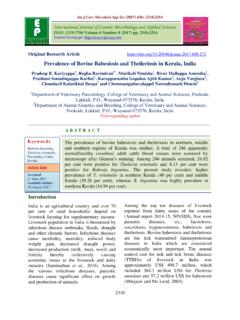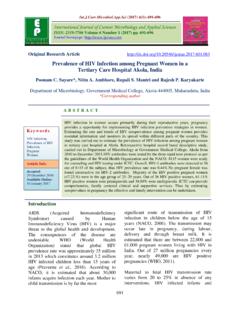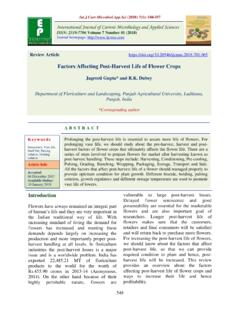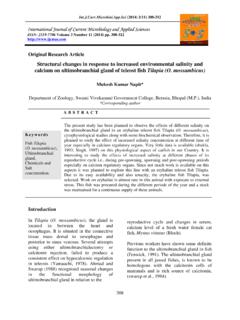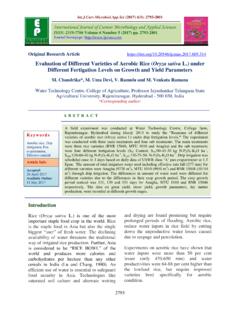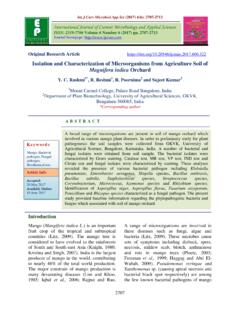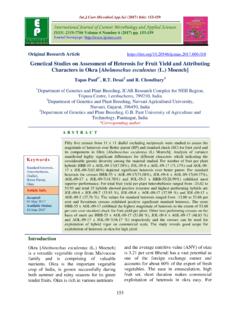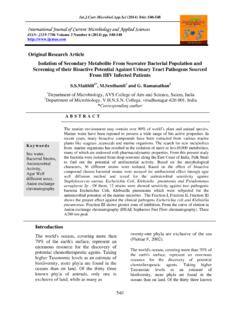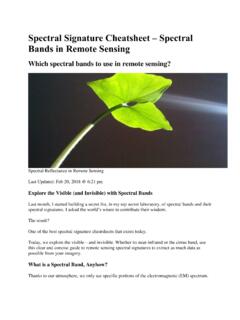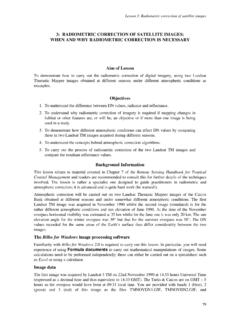Transcription of Applications of Remote Sensing in Agriculture - A Review
1 (2019) 8(1): 2270-2283 2270 Review Article Applications of Remote Sensing in Agriculture - A Review P. Shanmugapriya*, S. Rathika, T. Ramesh and P. Janaki Anbil Dharmalingam Agricultural College and Research Institute, Tamil Nadu Agricultural University, Tiruchirapalli-620027, India *Corresponding author: A B S T R A C T Introduction Remote Sensing is the art and science of gathering information about the objects or area of the real world at a distance without coming into direct physical contact with the object under study. Remote Sensing is a tool to monitor the earth s resources using space technologies in addition to ground observations for higher precision and accuracy. The principle behind Remote Sensing is the use of electromagnetic spectrum (visible, infrared and microwaves) for assessing the earth s features.
2 The typical responses of the targets to these wavelength regions are different, so that they are used for International Journal of Current Microbiology and Applied Sciences ISSN: 2319-7706 Volume 8 Number 01 (2019) Journal homepage: Remote Sensing has several advantages in the field of agronomical research purpose. The assessment of agricultural crop canopies has provided valuable insights in the agronomic parameters. Remote Sensing play a significant role in crop classification, crop monitoring and yield assessment. The use of Remote Sensing is necessary in the field of agronomical research purpose because they are highly vulnerable to variation in soil, climate and other physico- chemical changes. The monitoring of agricultural production system follows strong seasonal patterns in relation to the biological life cycle of crops. All these factors are highly variable in space and time dimensions.
3 Moreover, the agricultural productivity can change within short time periods, due to unfavourable growing conditions. Monitoring of agricultural systems should be followed in timely. Remote Sensing are important tools in timely monitoring and giving an accurate picture of the agricultural sector with high revisit frequency and high accuracy. For sustainable agricultural management, all the factors which are influencing the agricultural sector need to be analysed on spatio-temporal basis. The Remote Sensing along with the other advanced techniques such as global positioning systems and geographical information systems are playing a major role in the assessment and management of the agricultural activities. These technologies have many fold Applications in the field of Agriculture such as crop acreage estimation, crop growth monitoring, soil moisture estimation, soil fertility evaluation, crop stress detection, detection of diseases and pest infestation, drought and flood condition monitoring, yield estimation, weather forecasting, precision Agriculture for maintaining the sustainability of the agricultural systems and improving the economic growth of the country.
4 K e y w o r d s Remote Sensing , Crop acreage estimation, Crop growth monitoring, Crop stress detection, Yield assessment, Weather forecasting Accepted: 14 December 2018 Available Online: 10 January 2019 Article Info (2019) 8(1): 2270-2283 2271 distinguishing the vegetation, bare soil, water and other similar features (refer figure 1). It can also be used in crop growth monitoring, land use pattern and land cover changes, water resources mapping and water status under field condition, monitoring of diseases and pest infestation, forecasting of harvest date and yield estimation, precision farming and weather forecasting purposes along with field observations. In essence, Remote Sensing techniques are used for earth s resources Sensing . Remote Sensing data can greatly contribute to the monitoring of earth s surface features by providing timely, synoptic, cost-efficient and repetitive information about the earth s surface (Justice et al.)
5 , 2002). It also has several Applications in the field of agro-meteorological purpose. Remote Sensing inputs combined with crop simulation models are very useful in crop yield forecasting. Since the ground based and air based platforms are time consuming and have limited use, these space based satellite technologies are gaining more importance for acquiring spatio-temporal meteorological and crop status information for complementing the traditional methods. Agricultural Applications Basic aspects During the early stages of the satellite Remote Sensing , most researchers are focused on the use of data for classification of land cover types with crop types being a major focus among those interested in agricultural Applications . In recent years, the work in agricultural Remote Sensing has focused more on characterization of plant biophysical properties. Remote Sensing has long been used in monitoring and analyzing of agricultural activities.
6 Remote Sensing of agricultural canopies has provided valuable insights into various agronomic parameters. The advantage of Remote Sensing is its ability to provide repeated information without destructive sampling of the crop, which can be used for providing valuable information for precision agricultural Applications . Remote Sensing provides a cheap alternative for data acquisition over large geographical areas (De beurs and Townsend, 2008). In India, the satellite Remote Sensing is mainly used for the crop acreage and production estimation of agricultural crops. Remote Sensing technology has the potential of revolutionizing the detection and characterization of agricultural productivity based on biophysical attributes of crops and/or soils (Liaghat and Balasundram, 2010). Data recorded by Remote Sensing satellites can be used for yield estimation (Doraiswamy et al.)
7 , 2005; Bernerdes et al., 2012), crop phenological information (Sakamoto et al., 2005), detection of stress situations (Gu et al., 2007) and disturbances. Remote Sensing along with GIS is highly beneficial for creating spatio-temporal basic informative layers which can be successfully applied to diverse fields including flood plain mapping, hydrological modelling, surface energy flux, urban development, land use changes, crop growth monitoring and stress detection (Kingra et al., 2016). The advances in the use of Remote Sensing methods are due to the introduction of narrow band or hyperspectral sensors and increased spatial resolution of aircraft or satellite mounted sensors. Hyperspectral Remote Sensing has also helped to enhance more detailed analysis of crop classification. Thenkabail et al., (2004) performed rigorous analysis of hyperspectral sensors (from 400 to 2500 nm) for crop classification based on data mining techniques consisting of principal components analysis, lambda lambda models, stepwise discriminant analysis and derivative greenness vegetation indices.
8 Many investigations have included different types of sensors which are capable of providing the reliable data on a timely basis on a fraction of the cost of traditional method of data gathering. Monitoring of vegetation cover The science of Remote Sensing play a vital role in the area of crop classification, crop acreage (2019) 8(1): 2270-2283 2272 estimation and yield assessment. Many research experiments were done using aerial photographs and digital image processing techniques. But the field of Remote Sensing helps in reducing the amount of field data to be collected and improves the higher precision of estimates (Kingra et al., 2016). The ability of hyper spectral data to significantly improve the characterization, discrimination, modeling, and mapping of crops and vegetation, when compared with broadband multispectral Remote Sensing , is well known (Thenkabail et al., 2011). This was helpful in establishing the 33 optimal HNBs and an equal number of specific two-band normalized difference HVIs are used to characterize, classify, model and map and also to study specific biophysical and biochemical quantities of major agricultural crops of the world (Thenkabail et al.)
9 , 2013). In relative to the crop condition, some Remote Sensing techniques are more focused on physical parameters of the crop system such as nutrient stress and water availability in assessing the crop health and yield. And other researchers are focused more on synoptic perspectives of regional crop condition using Remote Sensing indices. The most commonly used index to assess the vegetation condition is the Normalized Difference Vegetation Index proposed by Rouse et al., (1974). The NDVI has become the most commonly used vegetation index (Calvao and Palmeirim, 2004, Wallace et al., 2004) and many efforts have been made aiming to develop further indices that can reduce the impact of the soil background and atmosphere on the results of spectral measurements. An example of a vegetation index limiting the influence of soil on remotely sensed vegetation data is SAVI (Soil Adjusted Vegetation Index) proposed by Huete (1988).
10 The normalized difference vegetation index (NDVI), vegetation condition index (VCI), leaf area index (LAI), General Yield Unified Reference Index (GYURI), and Temperature Crop Index (TCI) are all examples of indices that have been used for mapping and monitoring drought and assessment of vegetation health and productivity (Doraiswamy et al., 2003, Ferencz et al., 2004, Prasad et al., 2006). Kogan et al., (2005) used vegetation indices from Advanced Very High Resolution Radiometer (AVHRR) data to model corn yield and early drought warning in China. Hadria et al., (2006) provides an example of developing leaf area indices from four satellite scenarios to estimate distribution of yield and irrigated wheat in semi-arid areas. Examples of vegetation indices which are used specifically in agricultural purpose are listed in the table 1. Crop condition assessment Remote Sensing can play an important role in Agriculture by providing timely spectral information which can be used for assessing the Bio-physical indicators of plant health.

